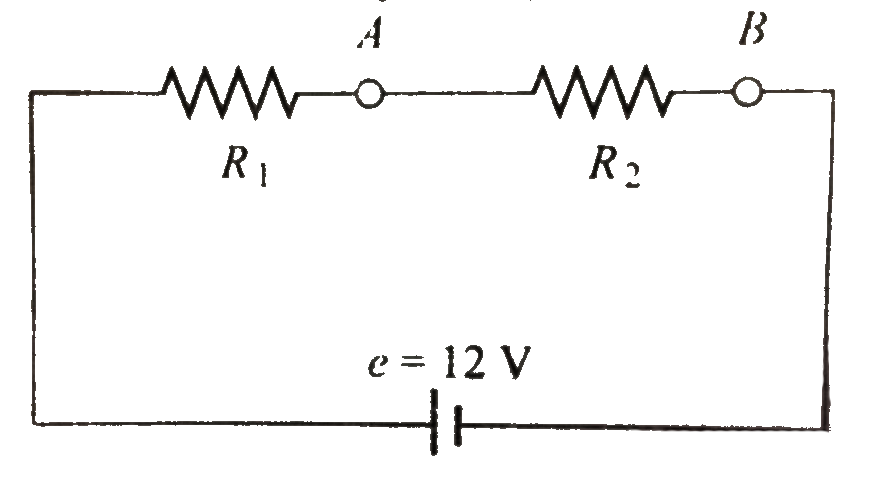A high tension (HT) supply of, say, 6 kV must have a very large internal resistance. Why?
A high tension supply should have high internal resistance. Otherwise, if the supply is accidentally short circuited, the circuit current will be exceedingly high (exceeding the safety limit) which may damage the appliances etc.
Topper's Solved these Questions
- CURRENT ELECTRICITY BOOK - U-LIKE SERIESCHAPTER - CURRENT ELECTRICITY EXERCISE - CASE BASED/SOURCE-BASED INTEGRATED QUESTIONS
10 Videos
- CURRENT ELECTRICITY BOOK - U-LIKE SERIESCHAPTER - CURRENT ELECTRICITY EXERCISE - MULTIPLE CHOICE QUESTIONS
35 Videos
- CURRENT ELECTRICITY BOOK - U-LIKE SERIESCHAPTER - CURRENT ELECTRICITY EXERCISE - SELF ASSESSMENT TEST (SECTION C )
3 Videos
- CBSE SAMPLE QUESTION PAPER 2019-20 (SOLVED)BOOK - U-LIKE SERIESCHAPTER - CBSE SAMPLE QUESTION PAPER 2019-20 (SOLVED)EXERCISE - SECTION D
6 Videos
- DUAL NATURE OF RADIATION AND MATTERBOOK - U-LIKE SERIESCHAPTER - DUAL NATURE OF RADIATION AND MATTEREXERCISE - SELF ASSESSMENT TEST SECTION-C (VERY SHORT ANSWER QUESTIONS)
3 Videos
Similar Questions
A : High voltage ( high tension ) supply must have very large internal resistance.
R: If the circuit is accidentally shorted , then the current drawn will not exceed safely limits if internal resistance is high.
View SolutionA low voltage supply, from which one needs high currents must have very low internal resistance. Why
View Solution
Knowledge Check
A : High voltage ( high tension ) supply must have very large internal resistance.
R: If the circuit is accidentally shorted , then the current drawn will not exceed safely limits if internal resistance is high.AIf both Assertion & Reason are true and the reason is the correct explanation of the assertion , then markBIf both Assertion & Reason are true but the reason is not the correct explanation of the assertion then mark.CIf Assertion is ture statement but Reason is false , then markDIf both Assertion and Reason are false statements then mark.A : A low voltage supply from which high currents are to be withdraw , must have very low internal resistance .
R : Maximum current drawn from a source is inversely proprtional to internal reisistance .AIf both Assertion & Reason are true and the reason is the correct explanation of the assertion , then markBIf both Assertion & Reason are true but the reason is not the correct explanation of the assertion then mark.CIf Assertion is ture statement but Reason is false , then markDIf both Assertion and Reason are false statements then mark.
A : A low voltage supply from which high currents are to be withdraw , must have very low internal resistance .
R : Maximum current drawn from a source is inversely proprtional to internal reisistance .
View SolutionA person with body resistance between his hands of 10KΩ accidentally grasps the terminals of a 18kV power supply.
(i) If the internal resistance of the power supply is 2000Ω, what is the power dissipated in his body?
(ii) What is the power dissipated in his body?
(iii) If the power supply is to be made safe by increasing its internal resistance, what should the internal resistance be for the maximum current in the above situation to be 1.00mA or less?
View SolutionA person with body resistance between his hands of 10KΩ accidentally grasps the terminals of a 18kV power supply.
(i) If the internal resistance of the power supply is 2000Ω, what is the power dissipated in his body?
(ii) What is the power dissipated in his body?
(iii) If the power supply is to be made safe by increasing its internal resistance, what should the internal resistance be for the maximum current in the above situation to be 1.00mA or less?
View SolutionThe emf of a cell is 6 V and internal resistance is 0.5kΩ. What will be the reading (in volt) of a voltmeter having an internal resistance of 2.5kΩ?
View SolutionThe emf of a cell is 6 V and internal resistance is 0.5kΩ. What will be the reading (in volt) of a voltmeter having an internal resistance of 2.5kΩ?
View SolutionWhen an ammeter of negligible internal resistance is inserted in series with circuit, it reads 1A. When a voltmeter of very large resistance is connected across R1, it reads 3V. But when the points A and B are short-circuited by a conducting wire, then the voltmetre measures 10.5V across the battery. The internal resistance of the battery is equal to

View Solution
